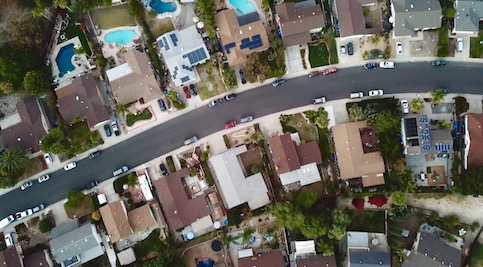Whenever you purchase homeowners insurance, update your policy or switch insurance carriers, you’ll receive a new homeowners insurance declaration page.
While the declaration page may seem fairly straightforward, there are essential elements you should know and look for as you review the document. Understanding the details of your homeowners insurance declaration page will help you get the most out of your policy. We’ll dive into what you’ll find in your declaration page next.
What Is A Homeowners Insurance Declaration Page?
A homeowners insurance declaration page (sometimes called a “dec page”) is a brief one-page summary of your homeowners insurance policy that highlights the types and amount of coverage you have along with how much it will cost you. It also includes your contact information, descriptions of the insured property and your premium.
See What You Qualify For
Buy A Home
Discover mortgage options that fit your unique financial needs.

Refinance
Refinance your mortgage to have more money for what matters.
Tap Into Equity
Use your home’s equity and unlock cash to achieve your goals.
What’s Included In A Homeowners Insurance Declaration Page?
Not only does this document outline the type and amount of coverage you’ve purchased, but it also shares key information about your policy that you’ll want to keep handy.
Name Of The Insured
At the top of the declaration page, you’ll see the names of the insured, which would be you and anyone else in your household covered under the policy. The page will list the primary policyholder first and then any additional people insured by the policy.
General Policy Information
Near the top of the page, you’ll also find the general information about your coverage, including your policy number, billing account number and policy period. Your policy period will show you when your coverage starts and stops.
Insured Property
Just like your auto insurance declaration page includes a rundown of your vehicle’s make and model, your homeowners insurance declaration page will include the address and type of residence you own.
Coverage And Limits
Perhaps the most important of all the sections, coverage and limits is a portion you’ll want to pay close attention to. This will cover the bulk of the middle part of your page and outline your coverages, limits and deductibles.
Premiums And Deductibles
Your dec page will also include your premium, or the exact amount you’ll pay for your property’s insurance protection for 1 year. Your deductibles, or the amount you will pay out of pocket when you file an insurance claim, will also be listed for easy reference.
Agent Contact Information
At the bottom, you’ll find the contact information for your insurance agent. You may want to take a photo of this information to keep handy in case of an emergency or for safekeeping.
Discounts
If you received any homeowners insurance discounts, these will also be reflected on your declaration page. The number of discounts available to you will depend on your insurance carrier, but a few to look into are:
- Making your home safer: By adding storm-resistant features to your home, such as storm shutters or reinforcing your roof, you may be able to save money on your homeowners insurance premiums. Your insurance agent will be able to give you a list of home improvements you can make that will result in a discount.
- Bundling your insurance: Certain insurance companies allow you to bundle your home, auto and liability insurance coverage. This can often result in a discount of 5% – 15%.
- Staying with the same insurer: Many insurance companies reward longtime customers with a loyalty discount. Staying with an insurer for 3 – 5 years can reduce premiums by up to 5%.
- Investing in home security equipment: Many insurance companies offer discounts of at least 5% when homeowners add a smoke detector, burglary system or deadbolt locks. Some companies will cut your premiums down by 10% – 15% if you invest in a more costly home security system.
- Maintaining a good credit history: Just like a certain credit score helps you buy a home, insurers often use credit history to inform prices for homeowners insurance policies. A few tips for maintaining a positive credit score include making payments on time and keeping your credit card balances as low as possible.
How To Review Your Homeowners Insurance Declaration Page By Section
This portion will likely be broken up into sections for property, liability, perils coverage and additional coverage.
Section 1: Property
The first section provides an overview of coverage for your property.
Coverage A: Dwelling
Dwelling coverage is the part of your homeowners insurance that will cover the costs related to the physical structure of your house in the event it’s damaged by a covered peril such as a fire or lightning strike.
Your dwelling coverage also includes your roof, built-in systems, appliances and attached structures like a garage or porch.
Coverage B: Other Structures
Other structures coverage offers protection for your detached structures such as a shed, detached garage, deck, pool or fence. This coverage protects your property from the same types of perils as your dwelling coverage, including fire and falling objects.
Coverage C: Personal Property
This coverage will reimburse you for any personal belongings that were stolen or damaged by a covered peril. This coverage includes everything from your clothing and electronics to portable appliances and jewelry.
If you own rare and expensive items, you may need to purchase additional coverage or endorsements that increase the reimbursement limits on your high-value belongings.
Coverage D: Loss Of Use
Loss of use coverage, also known as additional living expense coverage, may offer reimbursement for additional living expenses while your home is being repaired or rebuilt. This type of coverage is standard in most homeowners insurance policies and, depending on the coverage, will cover things such as fuel, hotel bills and grocery expenses.
Section 2: Liability
The second section covers issues related to liability coverage.
Coverage E: Personal Liability
Personal liability coverage protects you from costly lawsuits if you’re held liable for bodily injury or damage to someone’s personal property. This coverage includes many different occurrences such as dog bites or a diseased tree falling on your neighbor’s roof.
Coverage F: Medical Payments To Others
This coverage reimburses you for medical expenses related to a guest’s bodily injuries sustained while on your property, regardless of who was at fault. This is for small medical claims and most homeowners insurance policies offer coverage limits between $1,000 – $5,000.
Perils Coverage
Your perils coverage indicates what kinds of “perilous” events justify submitting an insurance claim. When it comes to the perils your homeowners insurance policy covers, the list is wide-ranging. Some of the common perils covered by a standard homeowners insurance policy include:
- Fire and smoke
- Lightning strikes
- Windstorms and hail
- Explosion
- Vandalism and malicious mischief
- Damage from an aircraft, car or vehicle
- Theft
- Falling objects
- Weight of ice, snow or sleet
- Water damage
A declaration page may include either a named perils or an open perils policy. With a named perils policy, you’re only covered for the perils named in the list. With an open perils policy, you’re covered for everything, except any perils listed.
Additional Coverage
Your dec page will also list additional or optional coverage you have chosen to include in your home insurance policy. Premiums associated with these additional coverage options can be found in the itemized section of the page.
A few examples of additional coverages include:
- Water backup coverage
- Service line coverage
- Identity theft protection
- Equipment breakdown coverage
- Scheduled property coverage
Discounts And Endorsements
The next part of your homeowners insurance policy that’s important to review is the discounts and endorsements section. The discounts are given by your insurer to lower the cost of your premium. It’s important to note that discounts can vary by state and insurer, so be sure to consult with your insurance agent to get an idea of what discount you might receive if you choose to invest in a home upgrade.
An endorsement is an optional additional coverage that protects parts of your home that aren’t covered in your standard insurance. Common endorsements include additional coverage for high-value items such as jewelry and art.
You can also opt for additional coverage for things like water backup coverage or extended replacement cost. This coverage will ensure your insurer pays for the cost of your home’s rebuild or restoration to your home’s original condition even if the damage is higher than your dwelling coverage limit.
Fund your renovations with a cash-out refinance.
See what you qualify for!
How To Review Premiums And Deductibles
Your declaration page will also list all of your premiums and deductibles.
What Are Insurance Premiums?
Your premium is the amount you have to pay to keep your policy active and ensure your property is protected. Premiums may be paid in one lump sum or over the course of monthly payments throughout the policy period.
Your homeowners insurance premium is determined by a number of factors, including how much coverage is in your policy, your credit score, your deductible amount and the size, build and age of your home.
What Are Insurance Deductibles?
Your deductible is the amount you’re responsible for paying until your insurance company will pay you for an insured loss. There are two types of homeowners insurance deductibles:
- Fixed deductible: This is a dollar amount that is specified in your dec page that indicates how much you will pay out of pocket when you file a claim.
- Percentage deductibles: These deductibles are specific to a named storm, windstorm or hurricane-related claim. These are calculated as a percentage of your home’s insured value.
Declaration Page FAQs
Have more questions about your insurance declaration page? We have answers.
Does my homeowners insurance declaration page contain information about all of my different types of coverage?
If you have different types of insurance coverage, you won’t find information about those policies on your homeowners insurance declaration page. Instead, each policy that you have will have its own declaration page. For instance, if you have auto and homeowners insurance through the same insurance company, you’ll receive separate documents for both.
Additionally, your dec page may not include optional add-ons you’ve purchased such as earthquake coverage or a sewer backup rider. Your declaration page is more of a quick reference summary than an extensive overview of every detail of your plan.
Where can I get my homeowners insurance declaration page?
Your dec page will be provided to you by your insurance company. It is typically the first page of your full homeowners insurance policy.
If you can’t find your dec page, contact your insurance company to have them mail you a physical copy or email you a PDF. Depending on your insurance company, you may be able to access your declaration page through your carrier’s website or app.
When will I need my homeowners insurance declaration page?
Your insurance declaration page is especially helpful as a reference as you’re filing a claim or looking to see if something specific is covered and what it might cost you.
When your policy is up for renewal, having this document handy helps you re-shop for homeowners insurance and compare your policy with the rates and coverage of other companies. This is especially important if you’re looking to change your homeowners insurance provider.
Is a declaration page the same as proof of insurance?
Yes, your homeowners insurance dec page also serves as proof of insurance. Typically, mortgage companies require homeowners to provide a declaration page as proof of insurance about once a year.
If you don’t provide this proof of insurance, some lenders might choose to purchase homeowners insurance in your name, which can be costly and might not be as comprehensive as you might like. This is another great reason to be sure that your homeowners insurance is up to date.
Get cash now for your next home improvement project.
Getting a personal loan is quick and easy.
The Bottom Line: Know Your Declaration Page
Now that you understand more about your homeowners insurance declaration page, be sure to keep this important document safe and in an easy-to-access space in your home. You may want to laminate your physical copy and keep a copy on your phone or computer for safekeeping.
If you still have questions, we have answers that can help you understand your needs for home insurance and other types of protection, such as home warranties. Learn more about home warranties and their costs to find out if they’re worth the investment.

Victoria Araj
Victoria Araj is a Staff Writer for Rocket Companies who has held roles in mortgage banking, public relations and more in her 15-plus years of experience. She has a bachelor’s degree in journalism with an emphasis in political science from Michigan State University, and a master’s degree in public administration from the University of Michigan.












